Mountaineers are being warned about beautiful snow formations that can become death traps in the mountains
The wind forms snow into shelves known as cornices that jut out from cliff tops with nothing but thin air below.
With snow now established in Scotland’s mountains, including the Cairngorms, The Mountaineering Council of Scotland (MCofS) has issued warnings of the unseen danger.
They may appear as beautiful curls of snow and ice from the side or below but for people walking on top of the mountain there can be little or no sign that they are there.
This makes it easy for someone to walk out on to a fragile shelf of snow which may collapse under their weight.
Recent strong winds and heavy snowfall mean cornices will have formed on many of the region’s mountain and will remain a hazard for the rest of the winter.
Heather Morning, mountain safety adviser for the MCofS, said: “It’s a very real hazard. Last winter there were 18 recorded incidents of people falling through cornices.
“They can be especially hard to detect if visibility is poor, in cloud or in falling snow.
“So if you are at all unsure of your ability to navigate, then turn around if the visibility becomes poor. The mountain will always be there another day. If the forecast is for poor visibility, then plan ahead and choose a lower mountain or a walk in the glen.
“If you are confident in your navigation skills then plan ahead. It is easy to anticipate where cornices will have formed by studying the prevailing few days’ weather pattern. Always err on the side of caution and navigate away from corniced edges.”
For those who are unsure about their abilities with navigation, the MCofrS subsidised mountain safety courses include several each year concentrating on navigation. See www.mcofs.org.uk/courses.asp for the range of courses.

